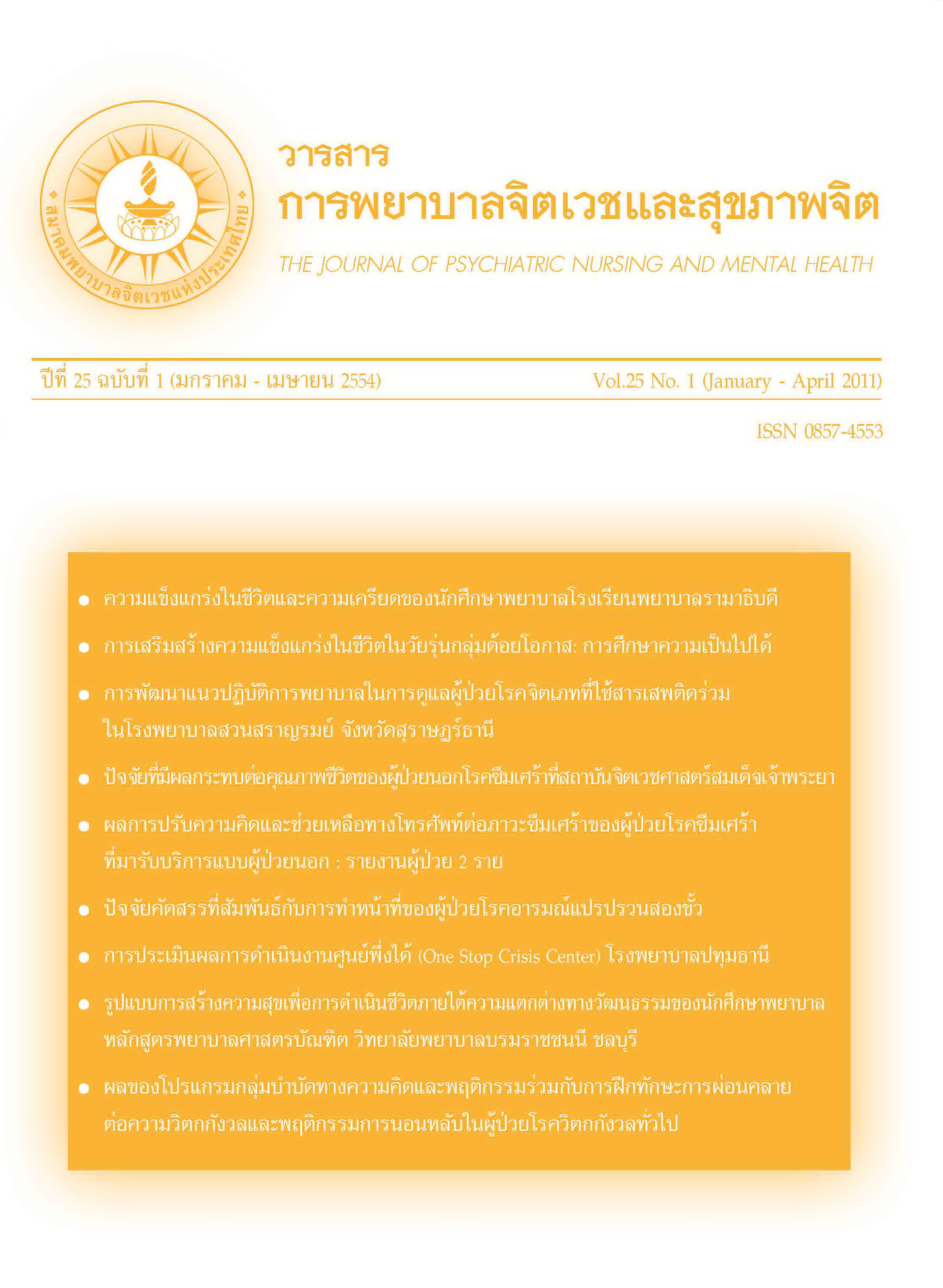ปัจจัยที่มีผลกระทบต่อคุณภาพชีวิตของผู้ป่วยนอกโรคซึมเศร้าที่ สถาบันจิตเวชศาสตร์สมเด็จเจ้าพระยา
Main Article Content
Abstract
บทคัดย่อ
การศึกษาครั้งนี้มีวัตถุประสงค์ เพื่อศึกษา ข้อมูลทั่วไป คุณภาพชีวิตและปัจจัยที่มีผลกระทบ ต่อคุณภาพชีวิตของผู้ป่วยโรคซึมเศร้าที่สถาบัน จิตเวชศาสตร์สมเด็จเจ้าพระยา ศึกษาในผู้ป่วยโรค ซึมเศร้าที่มารับบริการแผนกผู้ป่วยนอกจิตเวช ตั้งแต่ 2 ปีขึ้นไป สถาบันจิตเวชศาสตร์สมเด็จเจ้าพระยา จำนวน 263 คน เก็บข้อมูลตั้งแต่ 1 มกราคม 2553 ถึง 31 พฤษภาคม 2553 วิเคราะห์ ด้วยความถี่และร้อยละเพื่ออธิบายข้อมูลทั่วไป วิเคราะห์ความแปรปรวนแบบทางเดียว (One- Way ANOVA) เพื่อเปรียบเทียบคุณภาพชีวิต และวิเคราะห์ความถดถอยเชิงพหุ (Multiple Linear Regression Analysis) เพื่อหาปัจจัยทำนาย คุณภาพชีวิต
ผลการศึกษาพบว่าคุณภาพชีวิตของผู้ป่วย โรคซึมเศร้าอยู่ในระดับปานกลางร้อยละ 76 เพศชายและหญิงคุณภาพชีวิตไม่แตกต่างกัน คะแนนคุณภาพชีวิตที่สูงพบในผู้ที่มีสถานภาพ สมรสคู่ ( = 84.25 SD = 13.18) อาชีพรับราชการ และรัฐวิสาหกิจ (
= 92.42 SD = 11.62,
= 90 SD = 15.23) ระยะเวลาการเจ็บป่วยในช่วง 2-5 ปี (
= 84.56 SD = 15.01) ผู้ที่รักษาต่อเนื่อง (
= 83.96 SD = 14.38) ผู้ที่คิดว่ามีความรู้เกี่ยวกับ โรคซึมเศร้า (
= 84.70 SD=13.80) และคิดว่า โรคซึมเศร้ารักษาหายได้ (
= 87.34 SD = 12.14) ปัจจัยที่มีผลและสามารถร่วมคาดทำนายคุณภาพ ชีวิตของผู้ป่วยโรคซึมเศร้า ได้แก่ รายได้ สถานภาพ ทางการเงิน การรักษาต่อเนื่องและการรับรู้เกี่ยวกับ การหายของโรคซึมเศร้า โดยสามารถคาดทำนาย ได้ร้อยละ 14.5 (p-value = 0.001 R2 = 0.145) ดังนั้นการให้สุขภาพจิตศึกษาเกี่ยวกับการมารักษา ต่อเนื่อง การดำเนินโรคและการติดตามในกลุ่มที่ ขาดนัด จะช่วยป้องกันการป่วยซ้ำและเรื้อรัง ส่งผล ให้ผู้ป่วยโรคซึมเศร้ามีคุณภาพชีวิตที่ดีขึ้น
คำสำคัญ : คุณภาพชีวิต, โรคซึมเศร้า, ปัจจัยที่มี ผลกระทบต่อคุณภาพชีวิต
Abstract
The purposes of this research were to study the quality of life and factors that affect the quality of life in outpatients with depressive disorder. The simple consisted of 263 patients with depressive disorder who had been on continuous treatment for more than two years at outpatient department, Somdet Chaopraya Institute of Psychiatry during January 2010 to May 2010. The data was analyzed by percentage frequency. One-way ANOVA was used to determine the quality of life and Multiple Linear Regression was used to find out factors that affect the quality of life.
Result : Quality of life in outpatients with depression was at moderate level (76%). There was no significant difference between males and females. Quality of life scores were found to be highest among patients who were married ( = 84.25, SD = 13.18), government officials and state enterprises employees (
= 92.42 SD = 11.62,
= 90 SD = 15.23), duration of illness between 2-5 years (
= 84.56 SD = 15.01), patients who kept appointments (
= 83.96 SD = 14.38), patients who had knowledge of depressive disorder (
= 84.70 SD = 13.80) and thought that depressive disorder could be cured (
= 87.34 SD = 12.14). Related factors that could be used as predictive factors of quality of life in patients with depressive disorder were salary, financial status, continuity of treatments and perception of curability of depression, at 14.5% (p-value = 0.001 R2 = 0.145). Psychoeducation and pursuance of patients who fail to keep follow-up appointments may prevent relapses and chronicity of illness and enhance quality of life.
Keywords : quality of life, depression, factors affecting quality of life
Article Details
บทความที่ได้รับการตีพิมพ์แล้ว เป็นลิขสิทธิ์ของสมาคมพยาบาลจิตเวชแห่งประเทศไทย


